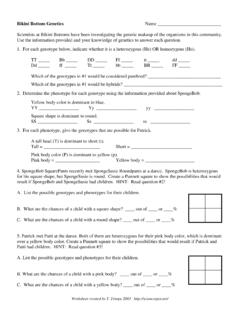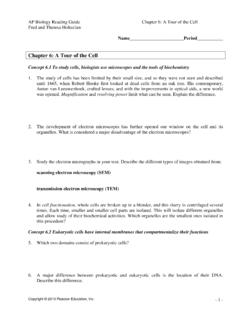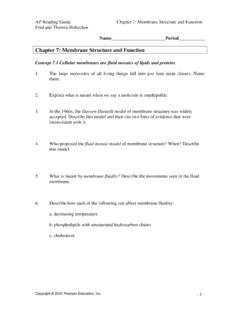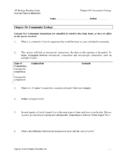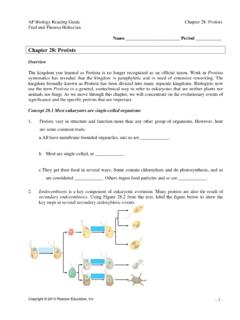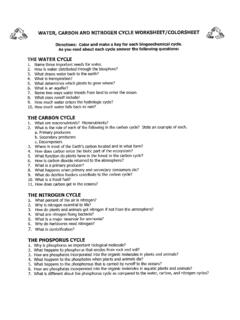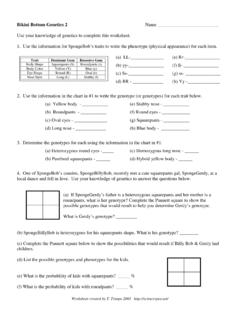Transcription of CHAPTER INTRODUCTION: THEMES IN THE STUDY OF LIFE
1 CHAPTER 1 introduction : THEMES INTHE STUDY OF s Hierarchical living world is a hierarchy, with each level of biological structure building onthe level below level of biological structure has emergent are an organism s basic units of structure and continuity of life is based on heritable information in the form of and function are correlated at all levels of biological are open systems that interact continuously with their mechanisms ensure a dynamic balance in living , Unity, and and unity are the dual faces of life on is the core theme of as a hypotheses are the hallmarks of the scientific and technology are functions of is a multidisciplinary adventureOBJECTIVESA fter reading this CHAPTER and attending lecture.
2 The student should be able describe unifying THEMES that pervade the science of the hierarchy of structural levels in how the properties of life emerge from complex seven emergent properties associated with between holism and how technological breakthroughs contributed to the formulation of thecell theory and our current knowledge of the between prokaryotic and eukaryotic , in their own words, what is meant by "form fits function." the five kingdoms of life and distinguish among describe how Charles Darwin's ideas contributed to the conceptual framework the scientific between inductive and deductive how science and technology are 1 introduction .
3 THEMES in the STUDY of LifeKEY TERMS emergent propertyholismevolutioncontrol grouppopulationreductionismnatural selectionvariablecommunityprokaryoticsci entific methodexperimental groupecosystemeukaryotichypothesisdeduct ive reasoningbiometaxonomyinductive reasoningscientific theorybiogenesisLECTURE NOTESB iology, the STUDY of life, is a human endeavor resulting from an innate attraction to life in itsdiverse forms ( Wilson's biophilia).The science of biology is enormous in scope. It reaches across size scales from submicroscopic molecules to the global distribution ofbiological communities.
4 It encompasses life over huge spans of time from contemporary organisms to ancestrallife forms stretching back nearly four billion a science, biology is an ongoing process. As a result of new research methods developed over the past few decades, there has beenan information explosion. Technological advances yield new information that may change the conceptualframework accepted by the majority of rapid information flow and new discoveries, biology is in a continuous state of flux. Thereare, however, enduring unifying THEMES that pervade the science of biology: A hierarchy of organization The cellular basis of life Heritable information The correlation between structure and function The interaction of organisms with their environment Unity in diversity Evolution: the core theme Scientific process: the hypothetico-deductive s Hierarchical living world is a hierarchy, with each level of biological structurebuilding on the level below itA characteristic of life is a high degree of order.
5 Biological organization is based on ahierarchy of structural levels, with each level building on the levels below 1 introduction : THEMES in the STUDY of Life3are ordered intoIn multicellular organisms similar cells are organised intoLarge scale communities classified bypredominant vegetation type anddistinctive combinations of plants andanimalsThe sum of all the planet's ecosystemsAtomsComplex biological moleculesSubcellular organellesCellsTissuesOrgansOrgan systemsComplex organismThere are levels of organization beyond the individual organism.
6 Population=Community=Ecosystem=Biomes=Bi osphere= level of biological organization has emergent propertiesEmergent property = Property that emerges as a result of interactions betweencomponents. With each step upward in the biological hierarchy, new properties emerge thatwere not present at the simpler organizational levels. Life is difficult to define because it is associated with numerous emergentproperties that reflect a hierarchy of structural of the emergent properties and processes associated with life are the organisms are highly ordered, and other characteristics of life emergefrom this complex energy-processing system ofcommunity interactions that includeabiotic environmental factors such assoil and waterPopulations of species living in the sameareaLocalized group of organisms belongingto the same species4 CHAPTER 1 introduction .
7 THEMES in the STUDY of organisms reproduce; life comes only from life (biogenesis). and Development. Heritable programs stored in DNA direct thespecies-specific pattern of growth and Utilization. organisms take in and transform energy to do work,including the maintenance of their ordered to Environment. organisms respond to stimuli from organisms regulate their internal environment to maintain asteady-state, even in the face of a fluctuating external Adaptation. Life evolves in response to interactions betweenorganisms and their properties of life emerge from complex organization, it is impossible to fullyexplain a higher level of order by breaking it into its = The principle that a higher level of order cannot be meaningfully explainedby examining component parts in isolation.
8 An organism is a living whole greater than the sum of its parts. For example, a cell dismantled to its chemical ingredients is no longer a is also difficult to analyze a complex process without taking it = The principle that a complex system can be understood by studying itscomponent parts. Has been a powerful strategy in biology Example: Watson and Crick deduced the role of DNA in inheritance bystudying its molecular STUDY of biology balances the reductionist strategy with the goal of understandinghow the parts of cells, organisms , and populations are functionally are an organism s basic units of structure and functionThe cell is an organism's basic unit of structure and function.
9 Lowest level of structure capable of performing all activities of life. All organisms are composed of cells. May exist singly as unicellular organisms or as subunits of invention of the microscope led to the discovery of the cell and the formulationof the cell theory. Robert Hooke (1665) reported a description of his microscopic examination ofcork. Hooke described tiny boxes which he called "cells" (really cell walls). Thesignificance of this discovery was not recognized until 150 years later. Antonie van Leeuwenhok (1600's) used the microscope to observe livingorganisms such as microorganisms in pond water, blood cells, and animal spermcells.
10 Matthias Schleiden and Theodor Schwann (1839) reasoned from their ownmicroscopic studies and those of others, that all living things are made of formed the basis for the cell theory. The cell theory has since been modified to include the idea that all cells comefrom preexisting the past 40 years, use of the electron microscope has revealed the complexultrastructure of cells. Cells are bounded by plasma membranes that regulate passage of materialsbetween the cell and its surroundings. All cells, at some stage, contain 1 introduction : THEMES in the STUDY of Life5 Based on structural organization, there are two major kinds of cells: prokaryotic cell = Cell lacking membrane-bound organelles and a membrane-enclosednucleus.
